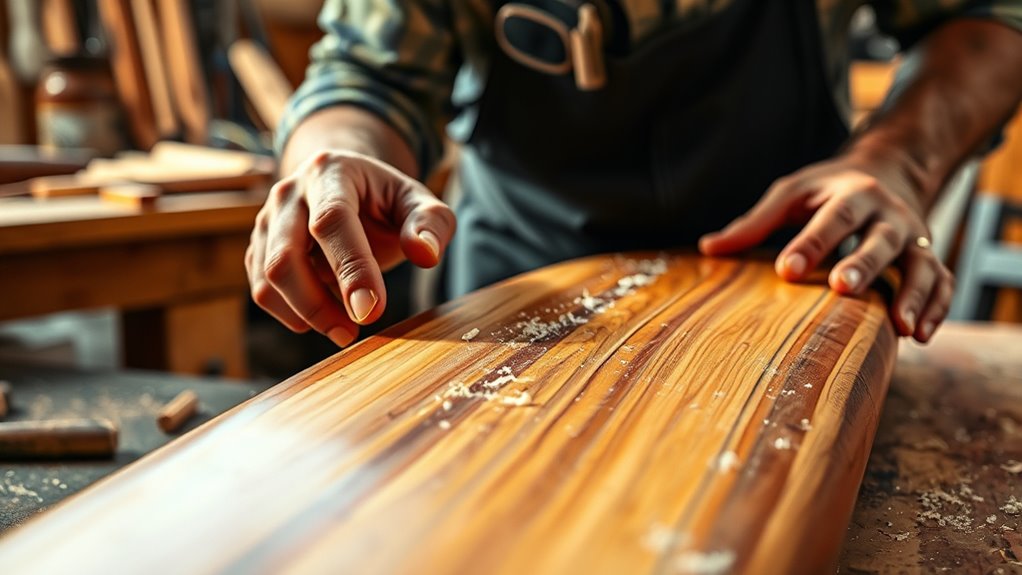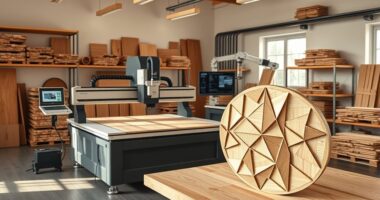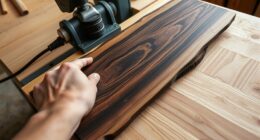Crafting a wooden surfboard involves selecting sustainable, durable woods like Paulownia, cedar, or bamboo, and shaping them with precision to match your riding style. Craftsmen use eco-friendly techniques, like natural oils and biodegradable sealants, to protect and finish the board, ensuring it’s water-resistant and long-lasting. The process highlights artistic craftsmanship and attention to detail, blending function with beauty. Keep exploring to discover how these timeless skills create unique surfboards that stand out on the waves.
Key Takeaways
- Skilled artisans select sustainable, high-quality woods like Paulownia, cedar, or bamboo for durability and eco-friendliness.
- Precise carving and shaping techniques create optimal contours, rocker, and rails tailored to surfing styles.
- Layered epoxy or natural sealants waterproof the board while preserving natural grain and aesthetic details.
- Hand-finishing with oils, beeswax, or plant-based resins enhances water resistance and highlights unique grain patterns.
- Customization and attention to grain orientation ensure each surfboard reflects craftsmanship, functionality, and natural beauty.
The Sustainable Choice: Why Wood Is Ideal for Surfboards
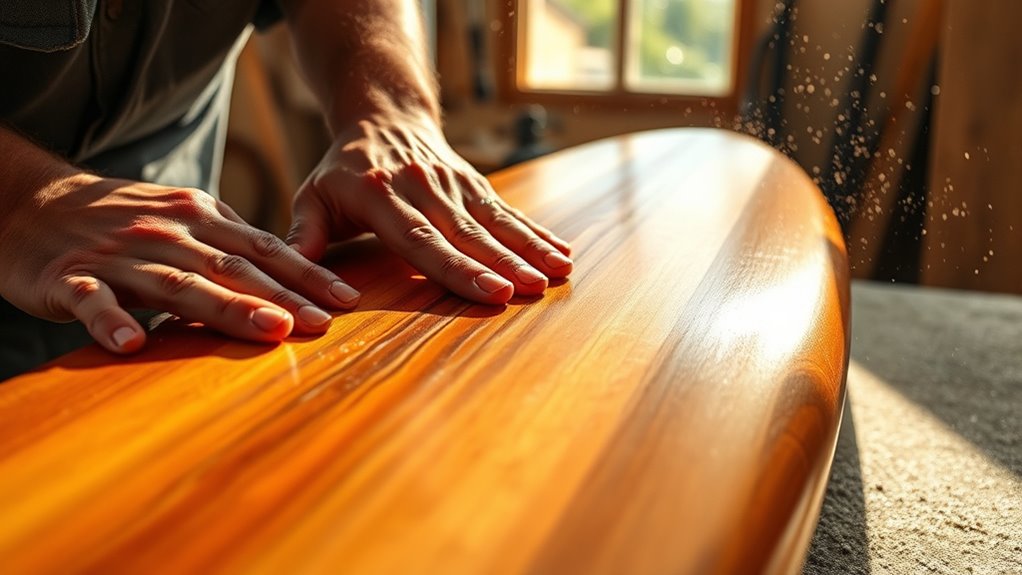
When choosing a surfboard, wood stands out as a sustainable and practical option. It’s made from sustainable materials like sustainably sourced Paulownia, which is both lightweight and strong, giving you durability without added weight. Wooden surfboards are biodegradable, meaning they break down naturally and have a lower environmental impact compared to foam and fiberglass boards. Their natural resilience guarantees they last longer, reducing the need for frequent repairs or replacements. Using wood also supports eco-conscious craftsmanship by promoting sustainable forestry and decreasing reliance on synthetic materials. Additionally, wooden surfboards require less energy-intensive manufacturing processes, further lowering their ecological footprint. Proper payment processing methods ensure secure transactions for eco-friendly businesses, encouraging more consumers to choose sustainable products. By choosing wood, you’re making a conscious decision that benefits both the environment and your surfing experience.
Selecting the Perfect Wood for Crafting
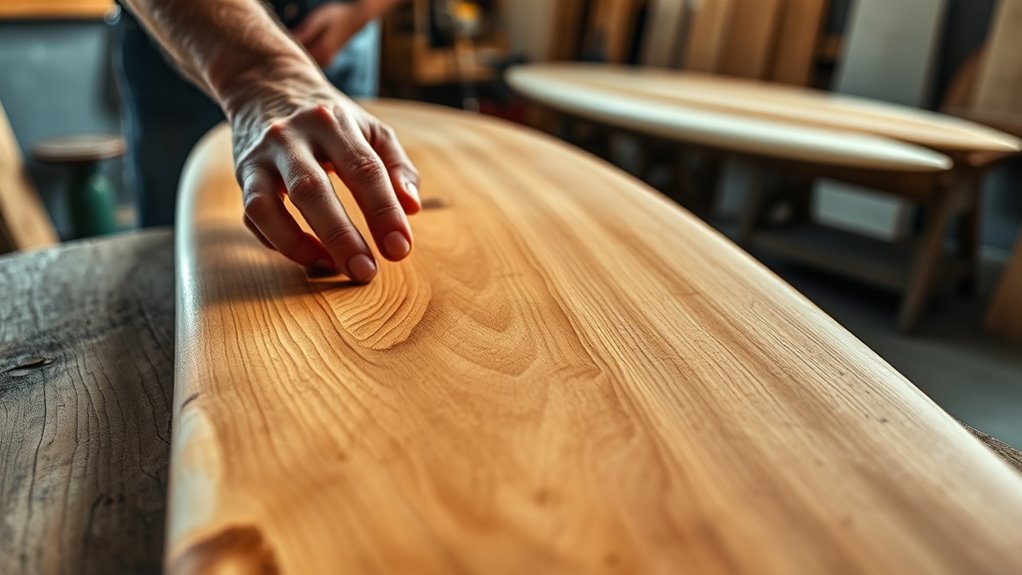
Choosing the right wood is key to crafting a high-performance surfboard, so you’ll want to evaluate options like paulownia for its lightness and moisture resistance or cedar and mahogany for durability and looks. Your choice impacts the board’s flexibility, weight, and overall feel, so balancing these factors ensures it meets your surfing style. Opting for sustainably sourced woods also helps protect the environment while creating a quality, eco-friendly board. Additionally, understanding the tuning options available for materials can help optimize the board’s performance and longevity, especially considering the benefits of using wood in terms of sustainability and efficiency. Exploring traditional woodworking techniques grounded in craftsmanship principles can further enhance the precision and durability of your surfboard. Incorporating traditional craftsmanship principles from historical butter-making techniques can inspire precise selection and treatment of materials to enhance durability and performance. For example, mastering the craftsmanship techniques involved in woodworking can lead to a more refined and resilient surfboard design.
Types of Suitable Wood
Selecting the right wood for your handcrafted surfboard involves considering several key factors, including weight, strength, water resistance, and sustainability. For wooden surfboards, materials like Paulownia stand out for being lightweight, strong, and moisture-resistant, making them ideal. Cedar and redwood are traditional choices valued for durability and beauty but are heavier. Bamboo offers a sustainable, flexible option with excellent strength and eco-friendliness, especially in hybrid designs. Marine-grade plywood, often made from birch or oak, provides a cost-effective, stable alternative. Advancements in material science have also led to the development of innovative composite materials that can further enhance surfboard performance. Understanding the properties of different wood types helps in selecting the best material for specific surfing conditions and personal preferences. Properly selecting your material can also influence the overall aesthetic appeal of your surfboard and how well it ages over time. When choosing the right material, considering its moisture resistance can help extend the lifespan of your board in harsh ocean environments. Here’s a quick comparison:
| Material | Weight | Strength | Sustainability |
|---|---|---|---|
| Paulownia | Light | Strong | High |
| Cedar/Redwood | Heavier | Very durable | Moderate |
| Bamboo | Moderate | Flexible, strong | High |
| Plywood | Moderate | Stable, reliable | Moderate |
Considering the advancements in material science, choosing the right wood can significantly impact the longevity and performance of your surfboard.
Durability and Flexibility
The durability and flexibility of the wood you choose directly impact your surfboard’s performance and longevity. Selecting the right wooden material involves balancing weight, strength, and water damage resistance. Consider these options:
- Paulownia: Known for its exceptional strength-to-weight ratio and natural resistance to water damage, making it ideal for long-lasting boards. Its renewable resource status also supports sustainable craftsmanship. Additionally, understanding credit card insights can help you manage the costs associated with high-quality materials.
- Hardwoods like Teak or Mahogany: Offer durability and rigidity, but may be heavier and less flexible. Understanding AI’s role in material selection can help optimize your choices for specific performance needs.
- Softwoods like Cedar: Provide more flexibility, which enhances responsiveness, but might need extra reinforcement to withstand water damage. Additionally, understanding symptoms of water damage can help you maintain your surfboard’s condition longer. Utilizing water-resistant treatments can further extend the lifespan of softer woods.
Sustainable Material Choices
Sustainable material choices play a crucial role in crafting eco-friendly wooden surfboards that perform well and last long. Selecting the right sustainable materials ensures your wooden boards are both environmentally responsible and high-quality. Paulownia wood is a top choice because it’s lightweight, strong, and sustainably harvested. Other options like cedar and oak are hardwoods that can be sustainable if sourced responsibly, such as FSC-certified or locally. The density and grain of the wood directly impact the board’s weight, buoyancy, and durability, so choosing carefully is essential for superior performance. Properly dried and treated wood also enhances longevity and water resistance, extending your surfboard’s lifespan. Additionally, understanding the environmental impact of materials can guide you in making more eco-conscious decisions. Incorporating sustainable practices into your craftsmanship process not only benefits the environment but can also set your work apart in the market. Being aware of the carbon footprint associated with different wood sources can further help in selecting the most eco-friendly options for your projects.
The Art of Shaping and Designing Wooden Boards
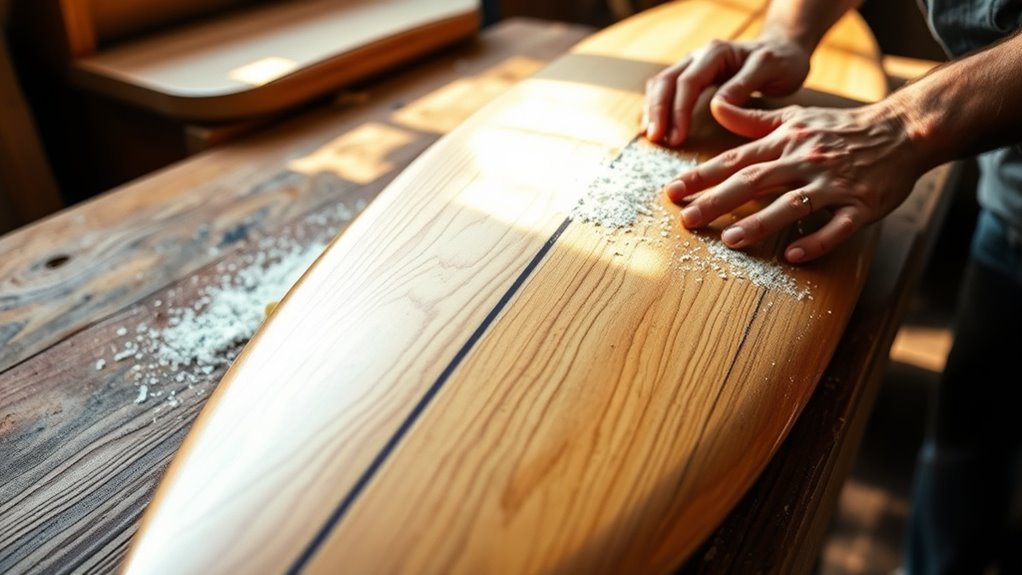
Shaping and designing wooden surfboards is a meticulous craft that transforms raw timber into a finely tuned riding instrument. Your process begins with carving and smoothing the wooden board using hand tools like planes, spokeshaves, and rasps. This craftsmanship allows you to create a balanced outline, rocker, and rails tailored to your riding style and wave conditions. To make your board stand out, you incorporate aesthetic elements such as decorative grain patterns, natural finishes, or inlays. Focus on three key steps:
- Carving the contours for ideal performance
- Refining the curvature with precise tools
- Adding decorative touches for visual appeal
Every detail reflects your craftsmanship, ensuring each wooden board is both functional and beautiful. Incorporating self-watering plant pots techniques can also inspire innovative approaches to sustainable and efficient design in woodworking projects, emphasizing the importance of materials selection for durability and aesthetics. Additionally, paying attention to grain orientation during construction can significantly influence the strength and appearance of the final piece.
Techniques for Assembling and Sealing
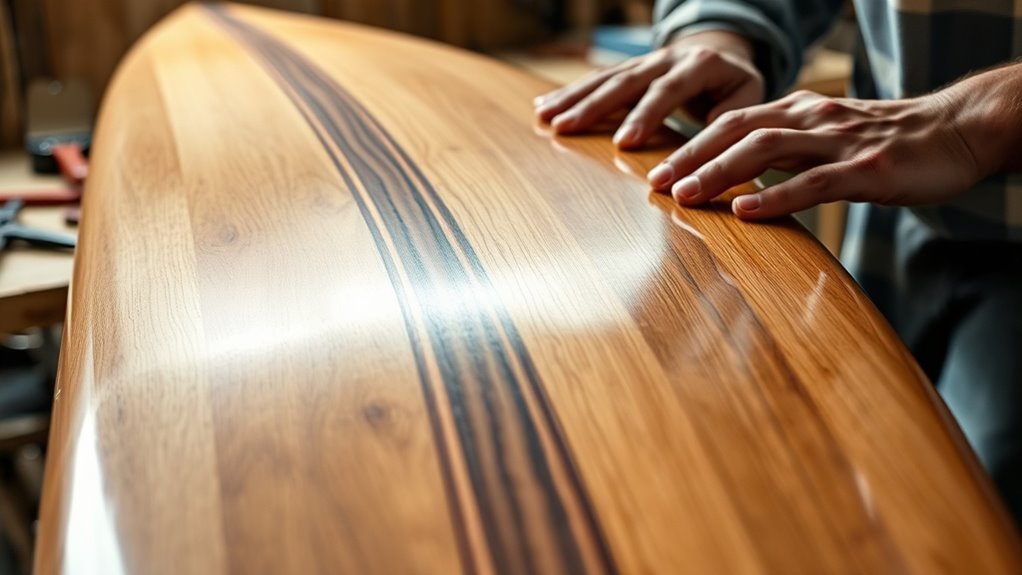
To assemble your wooden surfboard, you’ll join lightweight woods like Paulownia using precise carpentry techniques, ensuring a strong and smooth core. Sealing involves applying marine-grade epoxy or natural sealants that penetrate the wood and create a waterproof barrier. Choosing the right sealing materials and methods is essential to protect your board from water damage and keep it looking and performing its best.
Sealing Materials and Methods
Sealing your wooden surfboard effectively is essential to prevent water damage and guarantee durability. Choosing the right sealing materials ensures a waterproof barrier that lasts. Here are the key options:
- Epoxy resins – provide a strong, durable waterproof seal when applied in multiple coats, allowing each to cure fully.
- Polyurethane varnishes – create a flexible, water-resistant finish ideal for surfboards exposed to the elements.
- Natural oils – like linseed or tung oil, penetrate the wood, offering a breathable, water-resistant surface for traditional craftsmanship.
Applying these sealants evenly with brushes or spray guarantees consistency. Remember to sand between coats and pay close attention to edges and joints to eliminate vulnerabilities and enhance water resistance.
Assembly and Finishing Techniques
Assembling a wooden surfboard involves carefully constructing a lightweight frame from woods like Paulownia, then reinforcing it with internal stringers or ribs to guarantee strength and stability. During assembly, you assure all joints are precise and secure, often using traditional woodworking techniques like hand-planing and scraping to refine edges. Once assembled, you focus on finishing by sanding the surface smoothly to achieve a refined look and feel. To seal the board, you apply multiple coats of epoxy resin or marine-grade varnish, waterproofing the wood and protecting it from saltwater and sun damage. Final finishing touches include polishing with fine abrasives and applying wax to enhance glide, aesthetics, and environmental resistance. These assembly and finishing techniques combine craftsmanship and precision for a durable, beautiful surfboard.
Enhancing Durability With Eco-Friendly Finishes

Enhancing the durability of wooden surfboards with eco-friendly finishes involves selecting treatments that protect the wood while respecting the environment. By choosing options like natural oils, beeswax, and plant-based resins, you create a protective barrier against water, warping, and cracking. Water-based varnishes and varnish alternatives offer a glossy, durable shield without harmful VOCs. To maximize protection, consider these steps:
- Apply multiple thin coats of eco-friendly finishes to ensure even coverage.
- Use water-based varnishes for a resilient, environmentally safe finish.
- Opt for biodegradable sealants that preserve the wood’s natural look while reducing chemical runoff.
These sustainable practices help extend your surfboard’s lifespan and keep the environment safe during manufacturing and repairs.
The Unique Aesthetic and Personal Touch of Handmade Wooden Boards
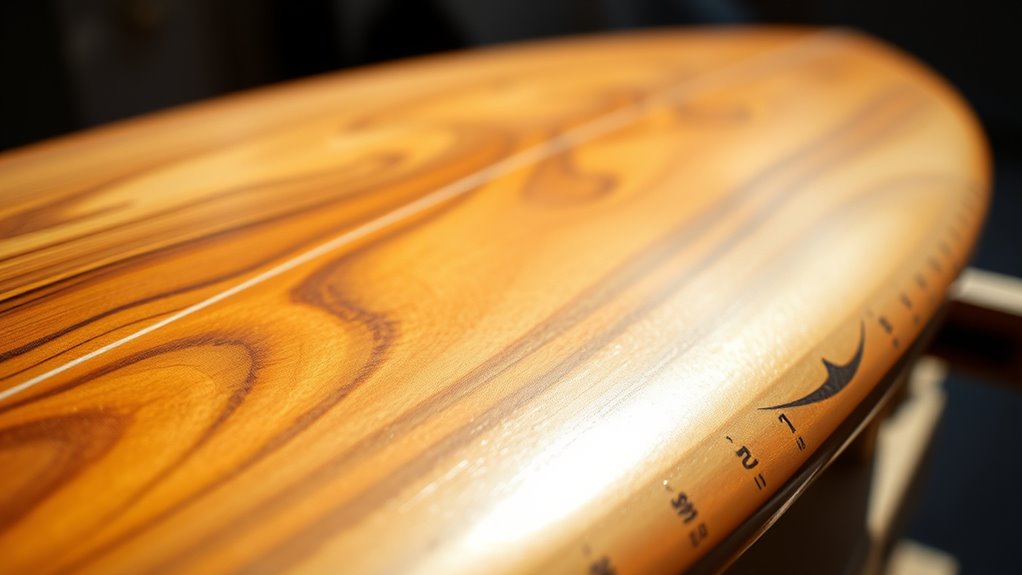
Handcrafted wooden surfboards stand out through their distinctive grain patterns and natural finishes, making each board uniquely yours. The hand-shaping process allows artisans to craft tailored curves and contours that reflect your style and preferences, adding a personal touch. These artisanal boards often feature subtle imperfections and variations that enhance their character, highlighting the skill and individuality of the craftsman. You can customize details such as wood type, color, and even engravings, turning your board into a true expression of personality. The natural beauty of wood, combined with expert craftsmanship, creates surfboards that serve as functional art pieces. Each handmade wooden board embodies a blend of aesthetic appeal and personal storytelling, making it more than just a surfboard—it’s a reflection of your connection to the craft.
Frequently Asked Questions
Are Wooden Surfboards Any Good?
You’re wondering if wooden surfboards are any good. They’re durable, eco-friendly, and can last for years with proper care, making them a smart investment. Yes, they’re heavier than foam boards, which might affect maneuverability, but they offer a smooth, natural look and customizable features that boost your style and performance. Overall, if you value sustainability and craftsmanship, wooden surfboards are a great choice for your surfing adventures.
Why Are Surfboards Made Out of Wood?
You might wonder why surfboards are made out of wood. Wooden surfboards are crafted for their durability, eco-friendliness, and unique aesthetic appeal. They’re typically made from sustainably sourced woods like Paulownia, which are lightweight yet strong. Plus, wood offers natural resistance to moisture when treated properly. While a bit heavier than foam boards, wooden surfboards provide a longer-lasting, environmentally conscious option that stands out in both performance and craftsmanship.
Why Is Paulownia Wood Good for Surfboards?
You’ll find that Paulownia wood is perfect for surfboards because it’s incredibly lightweight and strong, so your board stays durable without feeling heavy. Its rapid growth and sustainability make it an eco-friendly choice, aligning with your values. Plus, its natural resistance to water prevents warping, helping your surfboard last longer. The smooth surface also allows for a sleek finish, enhancing both the look and your riding experience.
How Long Do Wooden Surfboards Last?
You might wonder how long a wooden surfboard lasts. With proper care, such as regular sealing and keeping it dry, your wooden board can last between 10 to 20 years. Its durability depends on how often you surf, environmental exposure, and maintenance. When stored properly in a cool, dry place, many handcrafted wooden boards can become cherished heirlooms, often lasting for decades and providing you with years of surf adventures.
Conclusion
Imagine gliding atop a handcrafted wooden surfboard, feeling its warmth and unique grain beneath your feet. Every ride becomes a connection to nature’s artistry, a proof to sustainability and craftsmanship. With each wave you conquer, you carry a piece of the forest’s soul, crafted with care and respect. Embrace this eco-friendly journey, and let the timeless beauty of wood inspire your surf adventures, leaving a lasting impression both on the water and your heart.
